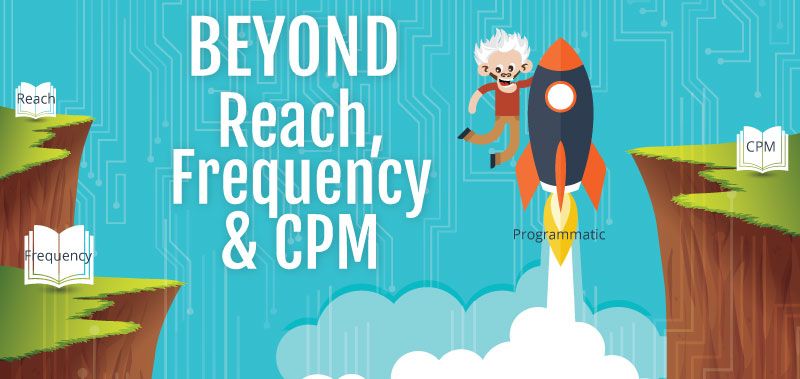
According to recent research, less than 30% of small businesses use website analytics. In fact, 18% of them admit that they do no tracking at all. Also, one third of advertisers indicate that they don’t know which digital marketing tactic produces the largest positive impact on their bottom line. As an example, 26% say that it’s email, 17% say it’s SEO, 15% indicate that it’s paid search and 5% speculate that it’s online display advertising. So where is the truth?
True “programmatic” digital media is stepping up to take its place amongst the most effective means of advertising. Unlike traditional marketing tactics, which can more or less approximate what people see, programmatic digital media can precisely measure how people think, and what they do. Needless to say, this offers a very positive impact on marketing strategies, creative and successes.
The old, traditional means of advertising using television and magazine ads, for example, was measured by what is known as “Reach” and “Frequency” and traditional digital advertising added CPM (cost per thousand) to the mix.
“Reach” is a term that indicates the number of people (or households) exposed to a specific medium at a specific time. Until recently, the general consensus has been, “The more reach, the better the chance of getting in front of some of the right people.”
“Frequency” is the number of times that viewers in general are exposed to the same advertisement during a campaign. Until recently, the thinking was “The more we hit these people within the ‘reach,’ the better the chance of them taking action.”
“CPM” is a term used to denote the price of 1000 advertising impressions. It’s the way of charging and executing traditional digital campaigns.
While Reach, Frequency and CPM are known as the “Pillars” of the measurement of TV, print and traditional digital media, they can only result in guesswork-simply an estimation. In other words, the traditional ways of measuring the total television and print audience no longer make up the entire marketing pie. In comparison to what programmatic digital media is capable of, these old methods represent just a small slice of the entire picture. For the advertising industry to envision the entire pie, they are going to have to rely on the continued upcoming trends and advanced technology of programmatic digital metrics.

In the vast world of advertising, digital media is still considered by some to hold less weight than the traditional methods. When marketers purchase media for major ad campaigns, they routinely allot only a small percentage of their advertising budget towards digital, as it is recognized as just an extension of the traditional “reach and frequency.” But in reality, nothing could be further from the truth.
Traditional media marketing measures what people see, while programmatic digital media can precisely measure people’s behavior. This technology has enabled the marketing world to reach into places that were never thought imaginable by traditional marketers. When combined with traditional marketing, the advertiser is given a high-definition view of buyer interest, impact and intent.
Traditional means of measuring marketing effectiveness can be compared to someone throwing a large net into the ocean with the hopes of catching red snapper. Instead, they catch everything that happens to be swimming in the area, and very few red snapper. With programmatic digital tactics, we can learn precisely where the school of snapper hang out, when and what they eat and how they best like it served! We can now use a fishing pole and a hook with the proper bait, and drop it right in front of the faces of Mr. and Mrs. Snapper. That’s right, heat up the fry pan, because with programmatic digital marketing, you’re sure to have snapper on the dinner menu.
In this day and age of precise targeting advancements, the Reach, Frequency and CPM methods are on even shakier ground. That’s because the majority of consumers do not sit in their rooms watching television or reading a magazine, buying items that come across the airwaves or things that are found within the pages of their periodical. Now audiences can be targeted across all channels, at particular times of the day or night, on different mobile devices and screens. Whether particular customers are browsing on their tablets, shopping on their smartphones or sitting on their couches with their laptops, the “power of programmatic” is manifested in its ability to pinpoint those consumers and place pertinent, relevant ads in front of them.
Consumers leave a trail of “cookie crumbs” as they wander through the steps of a search. For instance, someone might have intentions of purchasing a boat. They may read reviews on the Boating Magazine website. They may watch YouTube videos about a particular brand or style of boat; or they may browse the online classifieds looking for boats with price tags between $10,000 and $20,000. They may look at the websites of the boat manufacturers, or visit dealers, and even read consumer forums. Each time they make one of these moves, they are leaving cookie crumbs along the way, which indicate a high propensity to make an imminent purchase. Today’s programmatic marketing technology allows us to follow that trail, and place specific ads in front of the face of the crumb dropper!

So all of this begs the question, “Why are some marketers stuck in the last millennium, using the antiquated methods of Reach, Frequency and CPM?” “Why not take full advantage of a targeting technology that practically places the fish right onto their plates?” “Why are some brand marketers so reticent to adopt the new programmatic digital advertising?” Old habits are hard to break, but the new habits are catching on and moving upward.
Programmatic metrics are starting to push this effective form of targeting right into the mainstream. That’s because numbers that accurately quantify interest, impact and intent across all platforms, screens and channels allow us to specifically target those who are approaching the point of purchase. That is becoming virtually irresistible to brand marketers who want to start using fishing poles instead of large nets.



